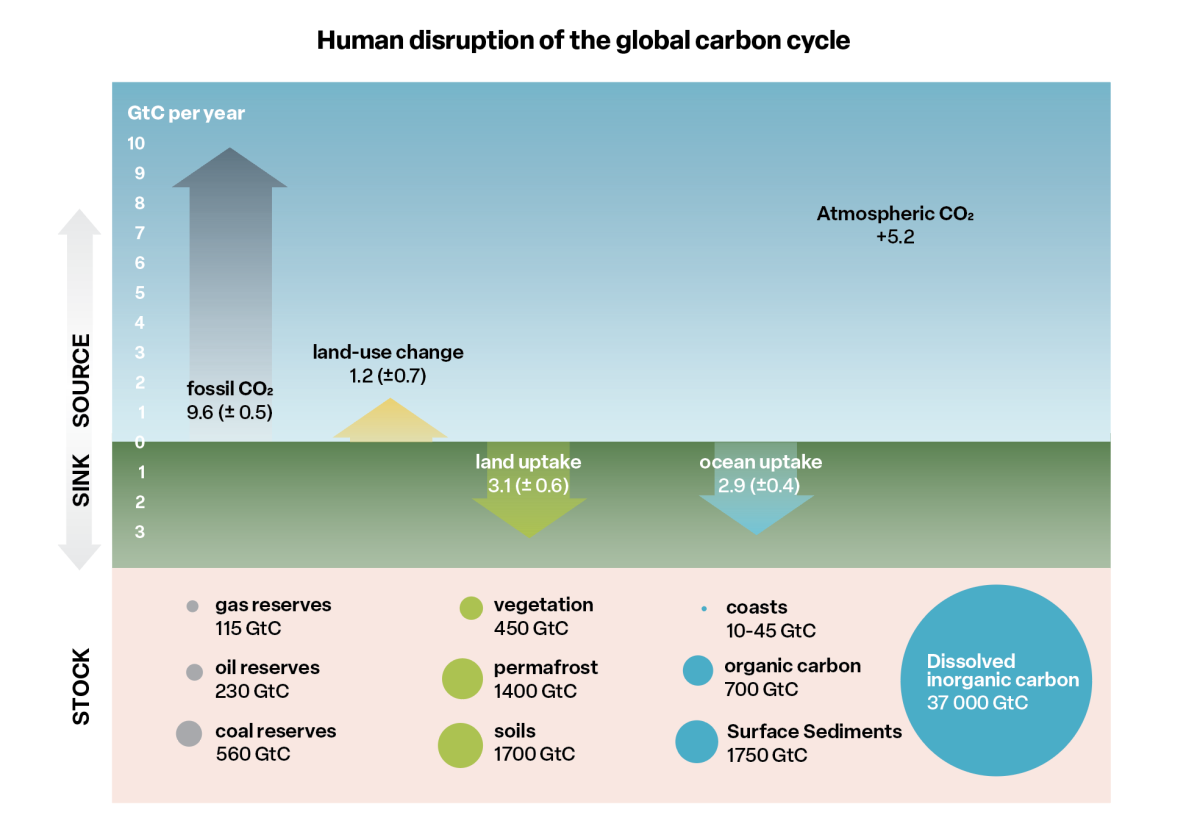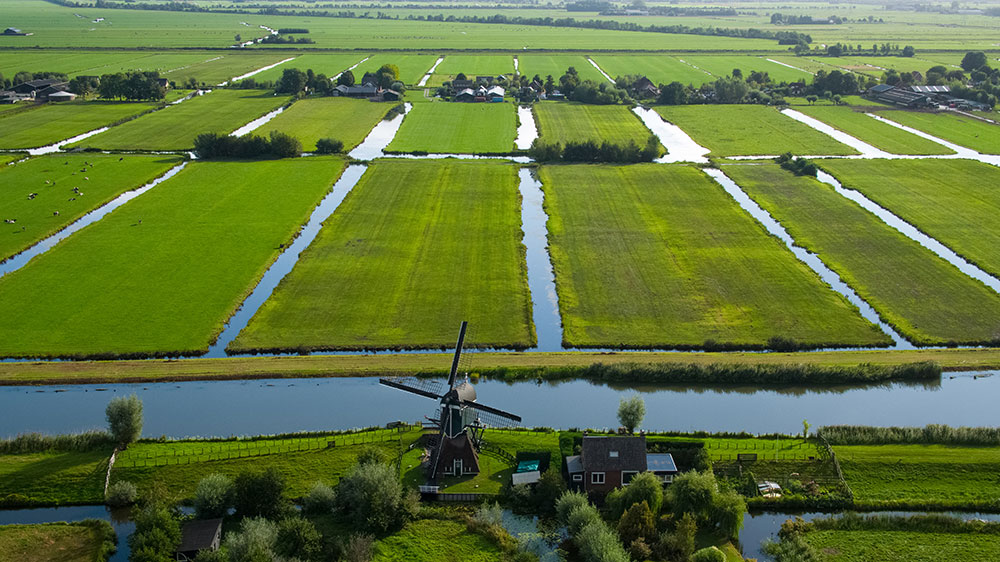Nature takes up carbon dioxide in its sinks, such as forests, soils and the ocean. For a carbon-neutral future to be realised, total human and natural emissions cannot exceed what sinks can absorb. Fossil fuel emissions must go to zero. ICOS provides almost real-time data on how nature responds to these reductions, which can be a powerful tool for informing which climate actions might actually be counterproductive.
Analysing nature-based carbon sinks and evaluating their potential and limitations requires understanding of the carbon cycle and clear definitions. The Intergovernmental Panel on Climate Change (IPCC) describes four major sources of greenhouse gases: fossil fuels (extraction and burning of coal, oil and gas), land use, land use change and forestry (deforestation, soil disturbances, etc). All of these sources release carbon dioxide (CO2). Other emissions, such as nitrous oxide and methane emissions from agriculture, are more potent greenhouse gases, but do not linger in the atmosphere as long as carbon dioxide. Of these three gases, CO2 is the greatest contributor to climate change.
As part of the natural carbon cycle on land, CO2 is taken up by plants, stored in biomass, dead wood and soils, and eventually released back to the atmosphere through respiration. In addition, CO2 is taken up and released by the ocean through a combination of biological and abiotic processes. These exchanges of gases between plants and the atmosphere, and the ocean and the atmosphere, are often called fluxes.
Currently, the uptake and release of carbon dioxide by land ecosystems and oceans is almost in balance, with uptake being slightly higher than release. This net uptake of natural CO2 compensates for a part of fossil fuel CO2 emissions. However, the majority of fossil fuel emissions linger in the atmosphere for hundreds of years, increasing the CO2 concentration.

Furthermore, the well-being and productivity of ecosystems are severely threatened by climate change. Temperature increases, changes in precipitation patterns and ocean acidification decrease sink capacity – alongside the pressures and strains human activity has on natural resources.
The carbon dioxide levels in the atmosphere will continue to rise dangerously until all sources and sinks, natural and human, are in balance. This balance is often called carbon neutrality, or net zero.
The most important climate action, therefore, is to reduce fossil fuel emissions as fast as possible. The second most important climate action is to reduce emissions from agricultural land use and land use change, e.g. by reducing deforestation, reducing the number of cattle, and improving fertilisation and other soil management methods.
These climate actions can be supported by measures that increase the carbon sink capacity – and here even more challenges start:
- What are the best ways to increase the number of long-lasting or even permanent carbon sinks?
- How do we predict the impacts of our actions?
- How are we going to monitor real success?
- How do we define additionality, e.g. whether our actions are increasing already existing carbon storage or uptake?
While legal rules and directives are under development, many of these questions remain unanswered.
The Green Deal requires scientific support
The EU has recently published several strategies and laws that seek to reach carbon neutrality, and is preparing additional measures. Many of these measures target reducing fossil fuel emissions. The newly-strengthened Emission Trading System, a mechanism through which companies must pay for their emissions, and tighter CO2 emission standards for cars, are two examples of such measures.
The Green Deal aims to reduce the EU's greenhouse gas emissions by at least 55% by 2030 with climate neutrality achieved by 2050. The Deal aims at increasing and strengthening carbon sinks as a tool to mitigate and adapt to climate change, thereby preserving biodiversity.
The envisaged increase in carbon sinks is mainly related to the land use, land-use change and forestry (LULUCF) sector: reducing emissions from croplands or drained wetlands, and strengthening existing sinks such as forests and permanent grassland soils. The goal is to get overall LULUCF fluxes towards a sink of 310 Mt CO2 equivalents by 2030.
The Green Deal in general and the related climate actions require strong scientific support and good dialogue between different actors. Scientists need to understand the needs of greenhouse gas emission inventory experts and policy-makers. In return, inventory experts will benefit from the latest scientific results. Long-term observational data plays a crucial role in both worlds and at their interface. This is exactly what research infrastructures and particularly ICOS can offer: ICOS measures greenhouse gases and the carbon cycle. With over 170 observation stations across Europe and the adjacent oceans, ICOS scientists deliver standardised, high-quality open data on land ecosystems, oceans, and the atmosphere, almost in real-time.
ICOS contributes to the Green Deal with long-term data and science-based knowledge
This FLUXES issue showcases ICOS contributions to Green Deal and other policies:
The carbon sink of European forests is rapidly decreasing, according to the latest greenhouse gas inventory report (2023). The reasons are manifold and need in-depth scientific analyses added to inventory calculations. ICOS observational data can be used together with modelling techniques to develop a validation and verification system for better estimating forest sinks and defining ways to increase them as envisaged in the LULUCF regulation. The Forest article discusses this.
Over the last few decades, many agricultural soils in Europe have suffered a depletion of organic carbon, posing a risk of decreased yields, particularly during dry years. The new Common Agricultural Policy, CAP, and the new Soil Law aim at protecting and improving soil conditions by reducing soil carbon losses or even increasing the organic matter stocks in soils where possible. Since the carbon stock in soils takes years, even decades, to change, we need long-term measurements with standardised methodologies to track these changes. This is the core competence of ICOS RI, which runs long-term observations in croplands. Adding more agricultural sites into the ICOS network would improve our understanding and validation of changes in soil carbon stocks. This would in turn allow for estimating the success of chosen management strategies on a country or EU level. The Carbon Farming article discusses this in more detail.
Another question is how actions with unknown success in the future can be monetised in the carbon offset market. Both LULUCF and the agricultural sectors are targeted by the new Carbon Removal Certification regulation, which is being discussed in the European Parliament and the Council during 2023-2024. According to the proposed criteria, carbon removals need to be quantifiable, additional, long-term and sustainable. ICOS data and science can give guidance and answers by defining certification rules and baseline information for measuring and verifying removals.
Carbon dioxide levels will continue to rise dangerously until all sources and sinks, both natural and human, are in balance.
The ocean is an important natural carbon sink, and currently absorbs 25-30% of human emissions annually. The ocean absorbs CO2 from the atmosphere, a process partly driven by physical properties like temperature, and partly by photosynthesis in marine vegetation such as algae, sea grasses, and salt marshes. This FLUXES issue takes a closer look at coastal marine ecosystems such as sea grasses that can sequester large amounts of carbon into sediments and vegetation. This is called blue carbon. Protecting existing marine ecosystems such as sea grasses, salt marshes and mangroves in the marine environment can significantly contribute to carbon dioxide removal. While most of the ICOS ocean stations do not observe carbon pools in sediments or biomass, dissolved carbon in the surface seawater is being measured, along with alkalinity, nutrients, salinity and dissolved oxygen. These measurements play an important role in monitoring the ocean carbon cycle and, by extension, the health of marine vegetation, i.e. blue carbon. Quantitative estimates of the European carbon cycle require more comprehensive observations of the coastal ocean. This also highlights the importance of cooperation across organisations and the development of new technologies.
In addition to CO2, other potent greenhouse gases like methane (CH4) and nitrous oxide (N2O) increase the complexity of mitigating climate change. Methane has both natural and human-related sources, and it has a complex chemistry in the atmosphere, making its growth difficult to estimate. The methane article looks at the reasons driving increasing concentrations of methane in the atmosphere.
Finally, we show estimates of carbon dioxide fluxes between ecosystems and the atmosphere (Net Ecosystem Exchange, (NEE), ocean-atmosphere fluxes, and fossil fuel emissions illustrated using a map of Europe. These estimates are from a highly-integrated product of measurements and models. ‘Net Ecosystem Exchange’ indicates the net CO2 exchange between plants and the atmosphere via photosynthesis and respiration. The map on fossil fuel emissions presents the distribution of CO2 sources from human activity.

